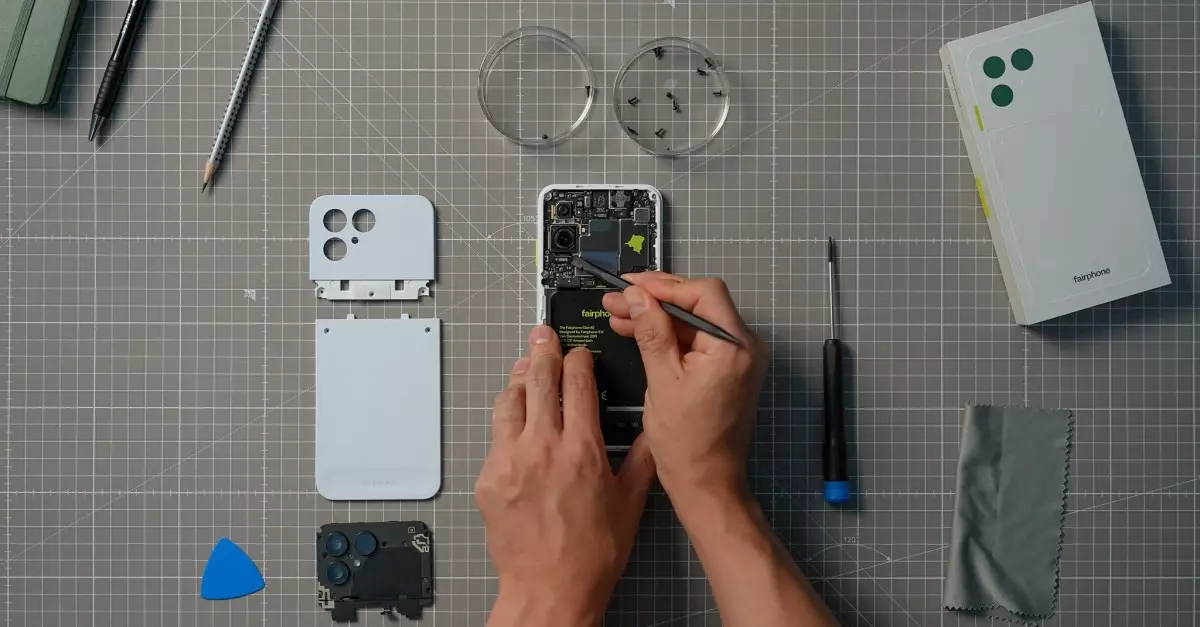The Fairphone 6 continues the legacy of its predecessors by setting a new standard for repairability in the smartphone industry. Unlike the typical trend of glued and soldered components that make repairs costly and complicated, this device exemplifies a user-centric approach to technology. Achieving a perfect score in iFixit’s teardown test for the fifth consecutive time, the Fairphone 6 demonstrates that high repairability can coexist with modern design. This persistent excellence raises a critical question: why aren’t more manufacturers adopting this model? The answer lies in the industry’s focus on capitalizing on hardware obsolescence rather than empowering consumers to maintain their devices. Fairphone’s commitment challenges this paradigm, emphasizing longevity and sustainability over planned obsolescence.
One notable aspect of the Fairphone 6’s design is its modularity. Though smaller than previous models, it maintains the ease of component replacement. The use of only a T5 Torx screwdriver, just seven screws, and minimal adhesives showcases a thoughtful engineering philosophy prioritizing repair simplicity. The orientation of the screws, particularly in enabling quick battery swaps, underscores the importance of user empowerment—highlighting that a device can be both sleek and functional without sacrificing repairability. The company’s rationale for requiring screws—to allow a slimmer, soft-pouch battery—strikes a balance between form and function, underscoring that durability doesn’t need to come at the expense of design.
Commitment to Sustainability and Long-term Support
Beyond repairability, Fairphone’s approach emphasizes a sustainability-driven philosophy. The company’s promise of seven years of Android updates and eight years of security patches explicitly targets the reduction of electronic waste. This is a radical departure from the industry norm of short-lived software support that often renders devices obsolete within a few years. Fairphone’s background illuminated by their long-term support programs affirms their dedication to sustainability and user ownership. The five-year warranty and loyalty scheme serve as additional incentives for consumers to keep and repair their devices rather than discard them at the first sign of a problem.
The significance of this approach extends beyond individual users—it represents a larger movement to combat the environmental impact of smartphone manufacturing. The cumulative effect of designing phones meant to last longer, supported by readily available spare parts and repair guides, could catalyze a shift in industry standards. Fairphone’s model illustrates that profitability and eco-consciousness are not mutually exclusive, challenging traditional business paradigms and prompting a reevaluation of what consumers should expect from their devices.
Trade-offs and Limitations: Quality versus Sustainability
Despite its revolutionary repairability and commitment to longevity, the Fairphone 6 concedes certain compromises in performance. The device’s camera array remains modest, and the Qualcomm Snapdragon 7S Gen 3 chipset lacks the raw power found in flagship phones. Additionally, the USB 2.0 port, while functional, may frustrate users seeking faster data transfer or charging speeds. These choices highlight a prioritization of sustainability and repairability over cutting-edge specs—an intentional trade-off that aligns with the company’s ethos.
The inclusion of a 10-120Hz LTPO OLED display suggests that Fairphone values a quality viewing experience, even if it can’t match the latest high-refresh-rate screens. The IP55 rating adds a layer of protection suitable for everyday use, but it is not the most robust sealing available, which might concern users in more extreme environments. Nonetheless, these limitations should be viewed through the lens of a conscious design philosophy: a device built to last and be serviced over the years, rather than replaced prematurely for incremental upgrades.
Economic and Geographical Factors Shaping Availability
Pricing and availability reveal further insights about Fairphone’s targeted market segments. Priced at €599 (~$705) in Europe, the Fairphone 6 positions itself as a premium product rooted in ethical and sustainable principles. Its higher US price point of $899, along with exclusive availability through Murena, which runs a privacy-focused Android fork, underscores how different markets influence device positioning. The limitation to alternative Android versions in the US reflects ongoing industry challenges related to software support, licensing, and partnerships that can complicate uniform distribution.
Preorders are open with a shipping date slated for August, signaling a strong interest from consumers seeking a more responsible and repair-friendly device. This also indicates that Fairphone is capitalizing on a niche—conscious consumers willing to invest more in a device that aligns with their environmental and ethical values. However, one must question whether the higher price point limits mass adoption and whether the industry will follow Fairphone’s lead in making sustainable devices more accessible.
In adopting a model where repairability and long-term support define the product, Fairphone is not merely producing a smartphone but sparking a fundamental shift in consumer expectations. Whether or not this shift becomes dominant remains to be seen, but one thing is clear: the Fairphone 6 could very well be the blueprint for the future of conscientious smartphone manufacturing.

